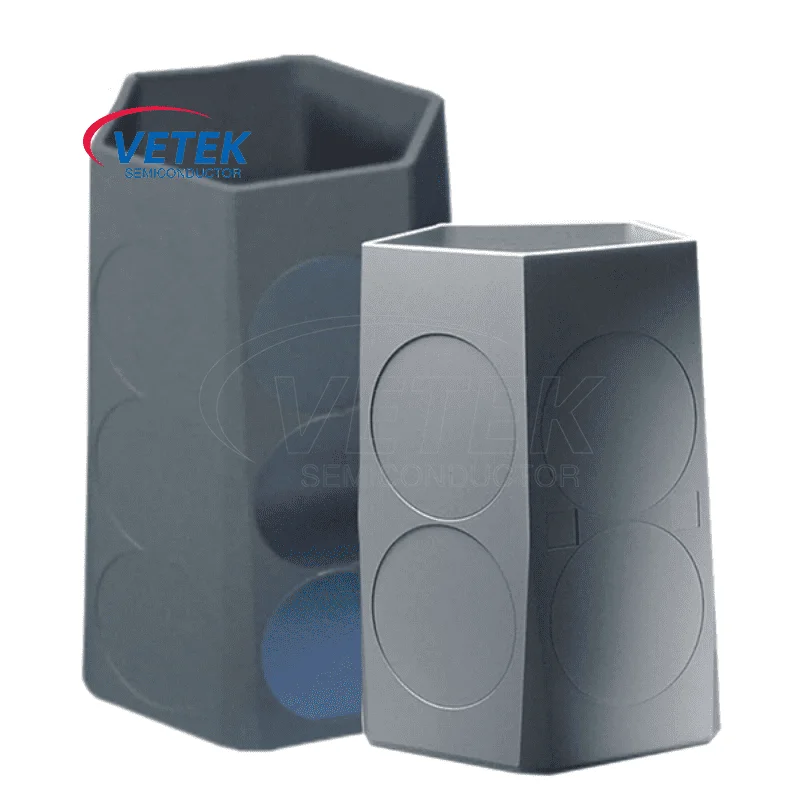
- English
- Español
- Português
- русский
- Français
- 日本語
- Deutsch
- tiếng Việt
- Italiano
- Nederlands
- ภาษาไทย
- Polski
- 한국어
- Svenska
- magyar
- Malay
- বাংলা ভাষার
- Dansk
- Suomi
- हिन्दी
- Pilipino
- Türkçe
- Gaeilge
- العربية
- Indonesia
- Norsk
- تمل
- český
- ελληνικά
- український
- Javanese
- فارسی
- தமிழ்
- తెలుగు
- नेपाली
- Burmese
- български
- ລາວ
- Latine
- Қазақша
- Euskal
- Azərbaycan
- Slovenský jazyk
- Македонски
- Lietuvos
- Eesti Keel
- Română
- Slovenski
- मराठी
- Srpski језик
Why does SiC coated Graphite Susceptor fail? - VeTek Semiconductor
2024-11-21
Analysis of Failure Factors of SiC Coated Graphite Susceptor
Usually, epitaxial SiC coated graphite Susceptors are often subjected to external impact during use, which may come from the handling process, loading and unloading, or accidental human collision. But the main impact factor still comes from the collision of wafers. Both sapphire and SiC substrates are very hard. The impact problem is especially common in high-speed MOCVD equipment, and the speed of its epitaxial disk can reach up to 1000 rpm. During the start-up, shutdown and operation of the machine, due to the effect of inertia, the hard substrate is often thrown and hits the side wall or edge of the epitaxial disk pit, causing damage to the SiC coating. Especially for the new generation of large MOCVD equipment, the outer diameter of its epitaxial disk is greater than 700mm, and the strong centrifugal force makes the impact force of the substrate greater and the destructive power stronger.
NH3 produces a large amount of atomic H after high-temperature pyrolysis, and atomic H has a strong reactivity to carbon in the graphite phase. When it contacts the exposed graphite substrate at the crack, it will strongly etch the graphite, react to generate gaseous hydrocarbons (NH3+C→HCN+H2), and form boreholes in the graphite substrate, resulting in a typical borehole structure including a hollow area and a porous graphite area. In each epitaxial process, the boreholes will continuously release a large amount of hydrocarbon gas from the cracks, mix into the process atmosphere, affect the quality of the epitaxial wafers grown by each epitaxy, and finally cause the graphite disk to be scrapped early.
Generally speaking, the gas used in the baking tray is a small amount of H2 plus N2. H2 is used to react with deposits on the surface of the disk such as AlN and AlGaN, and N2 is used to purge the reaction products. However, deposits such as high Al components are difficult to be removed even at H2/1300℃. For ordinary LED products, a small amount of H2 can be used to clean the baking tray; however, for products with higher requirements such as GaN power devices and RF chips, Cl2 gas is often used to clean the baking tray, but the cost is that the tray life is greatly reduced compared to that used for LED. Because Cl2 can corrode SiC coating at high temperature (Cl2+SiC→SiCl4+C), and form many corrosion holes and residual free carbon on the surface, Cl2 first corrodes the grain boundaries of SiC coating, and then corrodes the grains, resulting in a decrease in coating strength until cracking and failure.
SiC epitaxial gas and SiC coating failure
SiC epitaxial gas mainly includes H2 (as carrier gas), SiH4 or SiCl4 (providing Si source), C3H8 or CCl4 (providing C source), N2 (providing N source, for doping), TMA (trimethylaluminum, providing Al source, for doping), HCl+H2 (in-situ etching). SiC epitaxial core chemical reaction: SiH4+C3H8→SiC+byproduct (about 1650℃). SiC substrates must be wet cleaned before SiC epitaxy. Wet cleaning can improve the surface of the substrate after mechanical treatment and remove excess impurities through multiple oxidation and reduction. Then using HCl+H2 can enhance the in-situ etching effect, effectively inhibit the formation of Si clusters, improve the utilization efficiency of Si source, and etch the single crystal surface faster and better, forming a clear surface growth step, accelerating the growth rate, and effectively reducing SiC epitaxial layer defects. However, while HCl+H2 etches the SiC substrate in-situ, it will also cause a small amount of corrosion to the SiC coating on the parts (SiC+H2→SiH4+C). Since the SiC deposits continue to increase with the epitaxial furnace, this corrosion has little effect.
SiC is a typical polycrystalline material. The most common crystal structures are 3C-SiC, 4H-SiC and 6H-SiC, among which 4H-SiC is the crystal material used by mainstream devices. One of the major factors affecting the crystal form is the reaction temperature. If the temperature is lower than a certain temperature, other crystal forms will be easily generated. The reaction temperature of 4H-SiC epitaxy widely used in the industry is 1550~1650℃. If the temperature is lower than 1550℃, other crystal forms such as 3C-SiC will be easily generated. However, 3C-SiC is a crystal form commonly used in SiC coatings. The reaction temperature of about 1600℃ has reached the limit of 3C-SiC. Therefore, the life of SiC coatings is mainly limited by the reaction temperature of SiC epitaxy.
Since the growth rate of SiC deposits on SiC coatings is very fast, the horizontal hot wall SiC epitaxial equipment needs to be shut down and the SiC coating parts inside need to be taken out after continuous production for a period of time. The excess deposits such as SiC on the SiC coating parts are removed by mechanical friction → dust removal → ultrasonic cleaning → high temperature purification. This method has many mechanical processes and is easy to cause mechanical damage to the coating.
In view of the many problems faced by SiC coating in SiC epitaxial equipment, combined with the excellent performance of TaC coating in SiC crystal growth equipment, replacing SiC coating in SiC epitaxial equipment with TaC coating has gradually entered the vision of equipment manufacturers and equipment users. On the one hand, TaC has a melting point of up to 3880℃, and is resistant to chemical corrosion such as NH3, H2, Si, and HCl vapor at high temperatures, and has extremely strong high temperature resistance and corrosion resistance. On the other hand, the growth rate of SiC on TaC coating is much slower than the growth rate of SiC on SiC coating, which can alleviate the problems of large amount of particle falling and short equipment maintenance cycle, and the excess sediments such as SiC cannot form a strong chemical metallurgical interface with TaC coating, and the excess sediments are easier to remove than SiC homogeneously grown on SiC coating.




